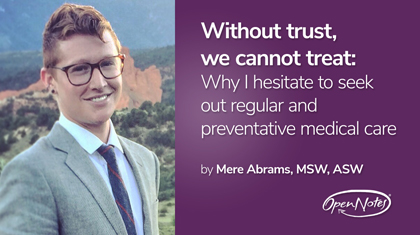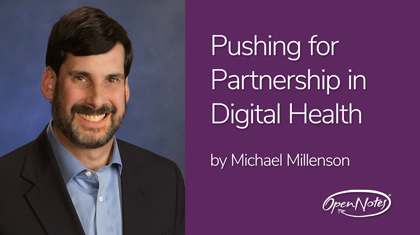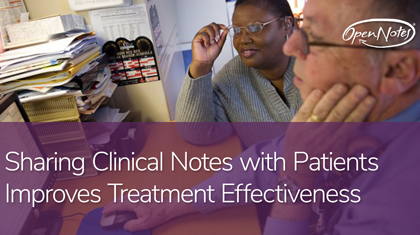by Stephanie D. Drobny, MS-HSL, RN, CPHQ – This form of team charting builds trust with patients and improves health literacy.
open notes
Why I hesitate to seek out regular and preventative care
by Mere Abrams, MSW, ASW SAN FRANCISCO, CA – Each time I go to the doctor, I pause before opening the door to the waiting room and take five deep breaths. I have no idea how I will be addressed, read, or referred to, even if it’s not my first appointment. As a trans nonbinary…
Pushing for Partnership in Digital Health
by Michael L. Millenson – CHICAGO, IL – Could OpenNotes help push predictive analytics from paternalism to partnership?
Sharing Clinical Notes With Patients Improves Treatment Effectiveness
by John Torous, MD – BOSTON, MA – Digital psychiatry – using new mobile and connected technologies towards mental health and wellness – offers tremendous potential.
What patients value about reading visit notes: a qualitative inquiry of patient experiences with their health information
Background: Patients are increasingly asking for their health data. Yet, little is known about what motivates patients to engage with the electronic health record (EHR). Furthermore, quality-focused mechanisms for patients to comment about their records are lacking.
Objective: We aimed to learn more about patient experiences with reading and providing feedback on their visit notes.
Methods: We developed a patient feedback tool linked to OpenNotes as part of a pilot quality improvement initiative focused on patient engagement. Patients who had appointments with members of 2 primary care teams piloting the program between August 2014-2015 were eligible to participate. We asked patients what they liked about reading notes and about using a feedback tool and analyzed all patient reports submitted during the pilot period. Two researchers coded the qualitative responses (κ=.74).
Student-accessible healthcare records: A mixed-method study of college student and provider
This mixed methods study evaluated student and provider attitudes and expectations about offering students online access to their student health services visit notes (open notes). Six (N=6) health care providers from four public universities in northeastern Massachusetts participated. Qualitative interviews were completed by students (N=14) from one University in fall of 2013 and an online survey was completed at two universities in Spring of 2014. Attitudes and expectations were explored using qualitative data and descriptive statistics were used to analyze survey questions. Students’ interviews revealed that they desire control over their health and open notes would give them insight and involvement in their health care. Survey data supported these themes. In contrast, providers worried about how it could impact provider-patient relationships. Open notes has the potential to promote students’ understanding and responsibility for their healthcare, which could assist students in their transition from pediatric to adult health care.
Patients and families as teachers: a mixed method assessment of collaborative learning model for medical error disclosure and prevention
Despite growing interest in engaging patients and families (P/F) in patient safety education, little is known about how P/F can best contribute. We assessed the feasibility and acceptability of a patient–teacher medical error disclosure and prevention training model. We developed an educational intervention bringing together interprofessional clinicians with P/F from hospital advisory councils to discuss error disclosure and prevention. Patient focus groups and orientation sessions informed curriculum and assessment design. A pre-post survey with qualitative and quantitative questions was used to assess P/F and clinician experiences and attitudes about collaborative safety education including participant hopes, fears, perceived value of learning experience and challenges. Responses to open-ended questions were coded according to principles of content analysis.
Soliciting patient feedback on visit notes: An educational opportunity
Patient and family engagement is gaining attention as a priority in patient care1 and medical education.2 OpenNotes, an innovation that invites patients to read their visit notes through a secure online portal, has demonstrated several health benefits.3 Over five million U.S. patients have online access to their notes today; shared visit notes may not only engage patients in care but also open the door to new educational innovations.
Intrigued by the idea of patient/family feedback on visit notes, our research team asked residents and their supervisors whether such feedback would be helpful.4 In surveys and focus groups, many agreed it would be.
When Patients Teach
As soon as the elevator door closed, the tears gave way, and I walked home with my head down … thoughts of my mistakes running rampant.
So began the reflection of a third-year medical student, who described falling short of his residents’ expectations on a history and physical examination. The crucial flaw? He had taken too long. His reflection continued:
[The next day], an elderly patient, traction stockings covering her small, dark brown legs, shuffled toward me. She stopped directly in front of me, her delicate, slightly stooped frame supported by her thin hand, grasping the IV pole. “Young man,” she said, “I heard you speaking to the patient in the bed next to me [last night]. And I just wanted you to know that I’m just so proud of you.… How you spoke to that patient with such care and intelligence. I’m just so proud.”
Time for quality measures to get personal
In its landmark report Crossing the Quality Chasm, the Institute of Medicine (IOM) identified six aims for shaping the future of health care.1 The report argued that care should be safe, effective, patient-centered, timely, efficient, and equitable. Some of these aims necessitate trade-offs with each other. For example, prioritizing effectiveness may constrain efficiency, or efficiency may compromise timeliness. Although there is no inherent conflict between effective care and patient-centered care, clinical practice guidelines and quality metrics often emphasize effectiveness over patient-centered care. In this article, in lieu of “patient-centered care,” which the IOM defined as “providing care that is respectful of and responsive to individual patient preferences, needs, and values and ensuring that patient values guide all clinical decisions,”1(p. 6) we use the term personalized care.








You must be logged in to post a comment.